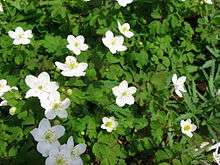Enemion biternatum
| Enemion biternatum | |
|---|---|
 | |
| Scientific classification | |
| Kingdom: | Plantae |
| (unranked): | Angiosperms |
| (unranked): | Eudicots |
| Order: | Ranunculales |
| Family: | Ranunculaceae |
| Genus: | Enemion |
| Species: | E. biternatum |
| Binomial name | |
| Enemion biternatum Raf. | |
| Synonyms | |
| |
Enemion biternatum (also Isopyrum biternatum), commonly known as the false rue-anemone, is a spring ephemeral native to moist deciduous woodland in the eastern United States and extreme southern Ontario.[1]
Description
The plant sends up evergreen basal leaves in the fall,[2] flower stems in the spring, and goes dormant in late spring and early summer after the seed ripens.
Leaves are twice or thrice compound with groups of three leaflets. Leaflets are smooth-edged, irregularly and deeply lobed twice or thrice, often with one to three secondary shallow lobes. Basal leaves are held on long stalks, and there are leaves arranged alternately up the flowering stems, with shorter stalks. All stems are reddish and hairless.[3]
The root system is weakly rhizomatous,[1] and occasionally produces small tubers. Plants spread over time to form thick colonies.[4]
The flowering stems are 4 to 16 inches (10 to 40 cm) high.[3] Flowers are produced singly or in leafy racemes of two to four flowers,[5] which means that there are leaves arranged alternately up the stems and flowers are in stems that come out of leaf axils. On either side of the leaf axils are two rounded stipules.[5]

The flowers have five white petal-like sepals that are each 5.5–13.5 mm (3⁄16–9⁄16 in) long and 3.5–8.5 mm (1⁄8–5⁄16 in) wide,[1] 25-50 stamens with yellow pollen on the anthers, and three to six green carpels.[6] If a carpel is fertilized, it develops into a beaked pod (follicle). When ripe, the pod splits open on one side to release several reddish-brown seeds.[5]
Ecology
The flowers produce pollen, but no nectar. Small insects such as sweat bees (Lasioglossum and Halictus), mining bees (Andrena), honeybees (Apis mellifera), and hoverflies visit the flowers to collect or feed on pollen. Some bees likely visit searching in vain for nectar.[4]
Status
Enemion biternatum is listed as a schedule 1 threatened species in Canada, where only 6 populations were reported in southwestern Ontario.[7]
Isopyrum biternatum is listed as an endangered species in Florida, where it has only been reported in Jackson and Washington counties.[8]
Similar species
Unlike the similar Rue-anemone (Thalictrum thalictroides), flowers appear in leaf axils, most often singly. In the Rue-anemone, flowers appear above a whorl of leaf-like bracts, most often in clusters of 3-6.
References
- 1 2 3 Ford, Bruce A. "Enemion biternatum ". Flora of North America (FNA). Missouri Botanical Garden. Retrieved 28 April 2016 – via eFloras.org.
- ↑ A. A. Reznicek, E. G. Voss, B. S. Walters (February 2011). "Enemion biternatum". Michigan Flora Online. University of Michigan. Retrieved April 29, 2016.
- 1 2 Chayka, Katy (2016). "Enemion biternatum (False Rue Anemone)". MinnesotaWildflowers.info.
- 1 2 Hilty, John (2016). "False Rue Anemone (Enemion biternatum)". Illinois Wildflowers.
- 1 2 3 Bebeau, G. D. (2013). "False Rue-anemone, Enemion biternatum Raf.". Plants of the Eloise Butler Wildflower Garden.
- ↑ Torrey, John; Gray, Asa (1838). A Flora of North America, Volume 1. New York: Wiley & Putnam. p. 660.
- ↑ Species profile for False Rue-anemone, Species at Risk Public Registry, Government of Canada, 2005.
- ↑ Richard E. Weaver, Notes on Florida's Endangered and Threatened Plants, 5th ed, Florida Bureau of Entomology, Nematology and Plant Pathology - Botany Section, 2010; page 39.
External links
| Wikimedia Commons has media related to Enemion biternatum. |
| Wikispecies has information related to: Enemion biternatum |
- Native Plant Identification Network
- Missouri Wildflowers (Isopyrum biternatum)
- IPNI Listing
- Kew Plant List